Wayward Strand is a narrative conversation videogame about visiting the elderly and infirm inhabitants of a flying hospital. I play as Casey Beaumaris, a teenage journalist who has been pressured by her mother, the hospital’s head nurse, into volunteering in a geriatric ward during her holiday weekend from school. Casey reluctantly agrees, planning to use the time to sleuth out a news story she can print in her highschool newspaper. By going from room to room in compressed time, Casey visits each of the six patients who live on the ward, learning about their lives, their interests, their former and future aspirations, and their gossipy opinions about each other, filling her notebook with incidental details for her story. It’s a wonderfully calm and atmospheric experience that fills me with warmth and affection for its characters.
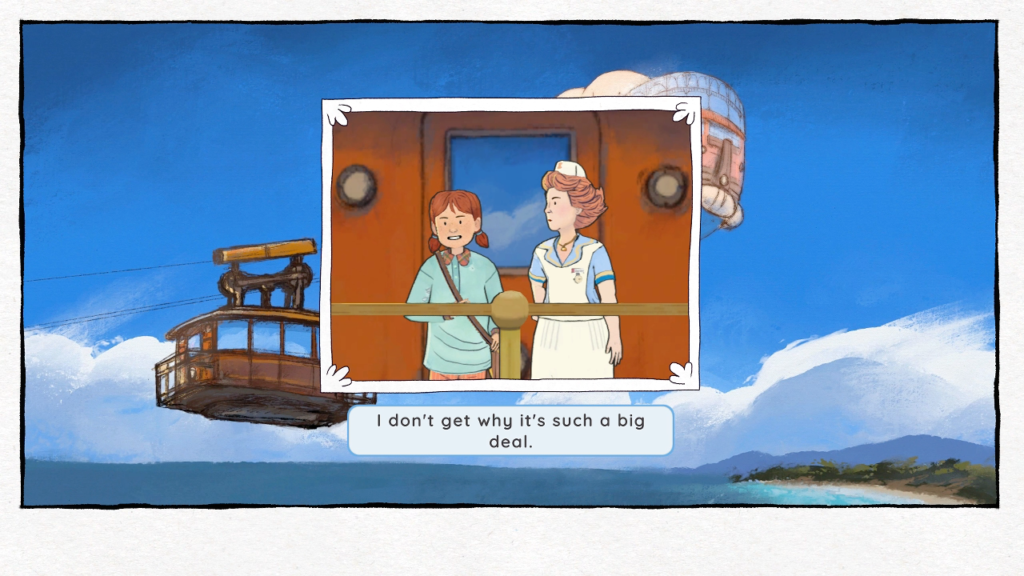
What’s most unusual about Wayward Strand’s airborne setting is it’s the only supernatural thing I experience. In function it is an ordinary hospital. An opening title card gives the date as January 27th, 1978, and despite this unlikely date the characters consider it much more incredible that the hospital was converted at great expense and some controversy from a luxury cruise vessel. It gets to a point that a simple dictation machine is treated with more wonder and novelty than the flying craft the characters live and work aboard. This impossible ship is treated as so ordinary that it drives Wayward Strand into magical realism territory, a high-brow literary genre where magical occurrences are treated as mundane and boring incidences in the unremarkable lives of regular people.
Into this semi-ordinary hospital comes the ordinary protagonist, Casey Beaumaris. As a fourteen year old girl, she would rather pursue her own interests than spend a three-day weekend volunteering in a hospital at her mother’s insistence. Her lack of enthusiasm is apparent from the first scene where she sulkily travels with her mother to the hospital by a suspended carriage. As soon as Mrs. Beaumaris realizes that Casey has brought along a notebook, her impatience with her daughter is apparent. It’s easy to imagine that Casey insists on turning everything into a journalistic enterprise and this behavior has become grating.
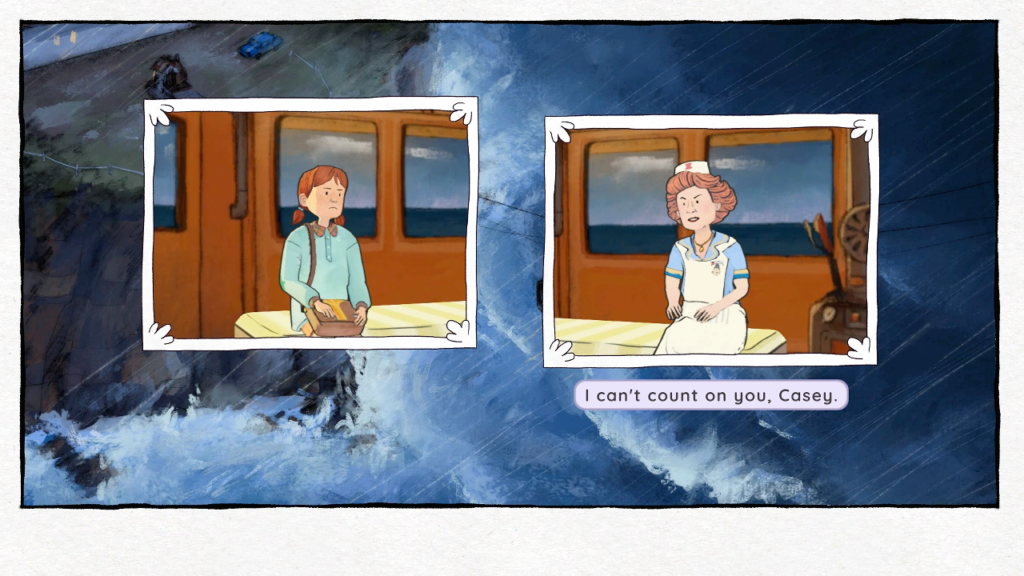
Despite this first impression, Wayward Strand spends much more time capturing Casey’s youthful perspective of her mother. Mrs. Beaumaris often holds her daughter to unfair standards, scolding Casey for her lack of effort and dismissing her defenses. Their relationship becomes quite frosty as the weekend progresses. As the only activity is to walk the ward’s halls and speak with its occupants, exactly what Casey has been asked to do, it’s easy to feel as frustrated as she does. I know perfectly well she’s doing everything expected of her but can do just as little to ward off Mrs. Beaumaris’ aspersions.
But looking past Casey’s perspective, I can see that Mrs. Beaumaris is strained by her demanding job. She is wrong to take her frustrations out on her daughter, but a sympathetic eye sees her as flawed, stressed, and tired, not contemptible. Casey’s growing affection for the hospital’s residents mirrors her developing understanding of her mother’s attitude, and their final conversation resolves the conflict as it ends the story. Their relationship is Wayward Strand’s core.
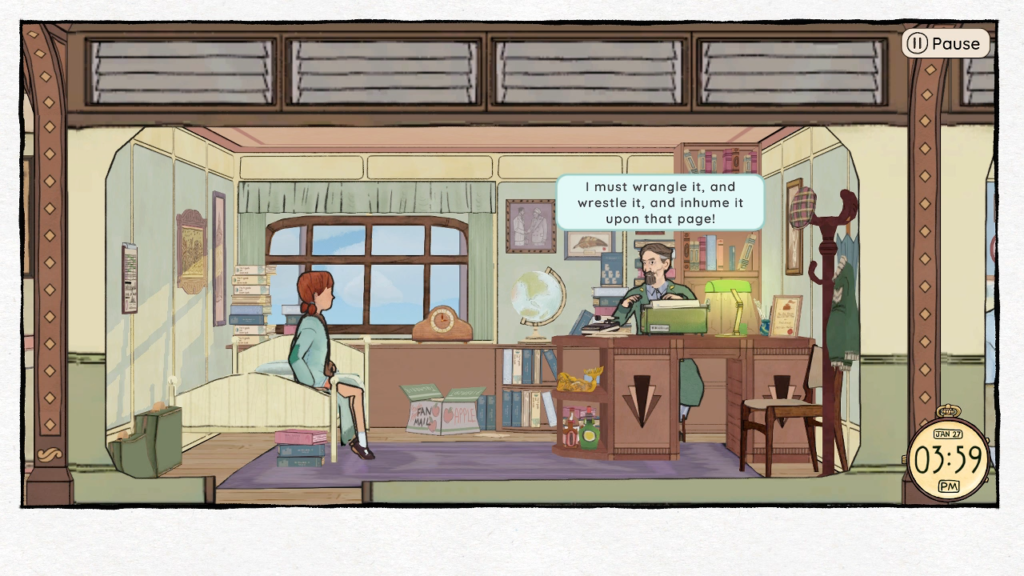
There are six residents aboard the hospital ship that Casey can spend her time with. There’s Ida Vaughan, a pleasant and grandmotherly woman. Next door to her is Neil Avery, an endearingly pompous and gregarious writer; he naturally forms an instant bond with Casey, a fellow writer, and gives her valuable career advice. On the top floor is Tomi Hummel, a quiet woman who tends a makeshift garden that spills out of her room into the hallway. On the bottom floor is Esther Fitzgerald, a superstitious and cantankerous woman; Mr. Pruess, a friendly, reserved man from Austria who speaks in halting English; and Dr. Bouchard, Casey’s former pediatrician, who is dying from terminal cancer and isn’t afraid to inflict her rage on visitors.
Wayward Strand wisely avoids diagnosing the hospital’s patients. I learn that Tomi is “non-verbal,” but this behavior is not described as a symptom of anything specific. Esther suffers from chronic pain and Mr. Pruess seems too weak to care for himself. Ida and Mr. Avery don’t appear to require hospitalization at all, though perhaps Casey caught them on a good weekend. It seems to be the videogame’s intent to avoid further pathologizing popular illness tropes, and the grace and sensitivity with which this is accomplished is commendable. The efficacy of the healthcare profession is also lightly touched upon, particularly how complaints of pain from women and people of color are often dismissed, though this is not a centerpiece of the narrative. Wayward Strand is more invested in Casey’s relationships than in making moral points.
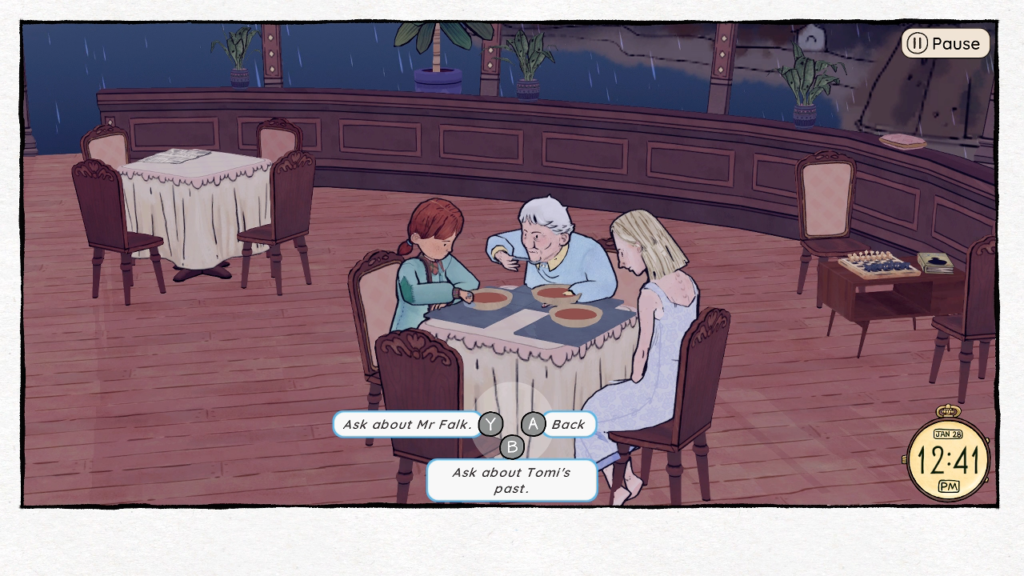
I guide Casey through the three decks that make up the hospital’s geriatric ward when visiting these patients. She can step into any patient’s room to begin a conversation with them. These unfold through familiar narrative videogame dialog trees, with new prompts opening based on recent events in the plot, conversations Casey has had with other characters, and details she has discovered examining objects throughout the ship.
More unfamiliar to the narrative videogame is being expected to wait. Sitting in silence for a few in-game minutes often prompts the other characters to ask Casey a question, which leads to further conversation. Narrative videogame protagonists can often seem like imperious interrogators, exhausting a list of pre-determined questions then marching on to the next nonplayer character to continue the plot. Wayward Strand demolishes this bad habit, lending further life to the conversations between these animated digital avatars.
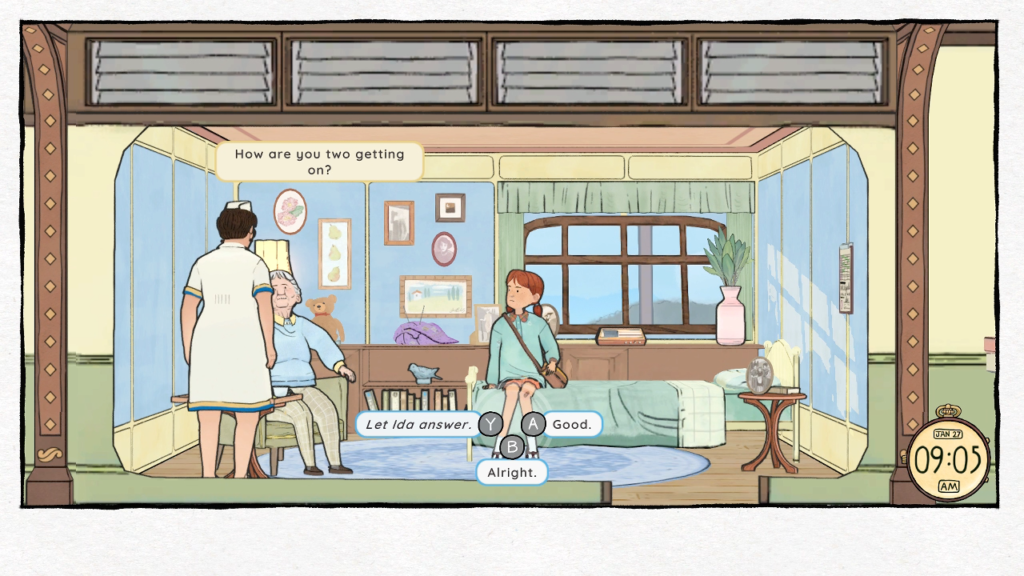
Not every character is available to speak at all times. Each has a schedule that takes them throughout the ship, visiting other characters, having lunch on the observation deck, and returning to their room to nap for a few hours. Lily, one of the ward nurses, often goes from room to room to check on the patients. In an impressive bit of scripting, if Casey is in the room then Lily will acknowledge her and maybe include her in the ensuing conversation. If she is not in the room, then the conversation still happens and I can direct Casey to lurk outside the room to eavesdrop, gaining new insight and details about the characters. Luckily, despite this rather rude behavior, few people seem to notice and nobody seems to mind.
These conversations are so natural and the voice acting so endearing it makes it easier to overlook the robotic way characters move around the ward. They walk in perfectly straight lines, stopping only to pivot in place, transparently following scripted flags from point to point. It’s most noticeable with Casey, who moves around the most as the player character, but it’s difficult not to see this behavior among any of the patients or staff. It’s the most visibly artificial part of a videogame that otherwise comports itself well through stylistic storybook visuals and impressive voiced performances.
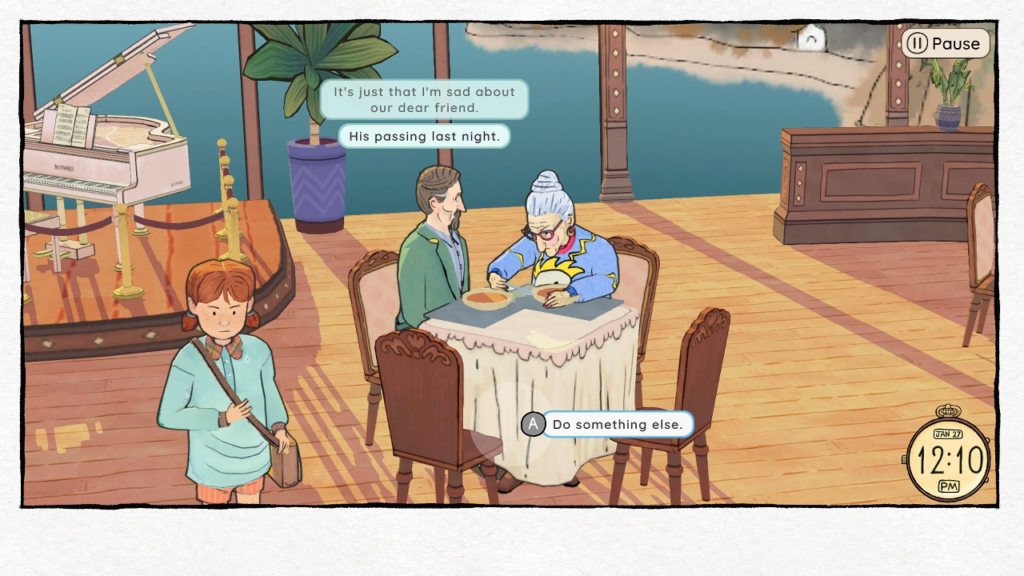
Wayward Strand is remarkable in its willingness to subvert its medium’s predilection towards goals. Despite Casey’s journalistic inquiries on her first day aboard the hospital ship, there is no greater mystery to solve. Hugo Falk dies shortly before Casey arrives; there is no subterfuge to be uncovered. A nurse named Joni mysteriously quit a few weeks before the narrative’s events; nobody quite knows why or where she went. Tomi has a set of gold, bear-shaped awards on her shelf; Casey’s queries about them leads her in circles between every patient, none of whom have answers but all believe another person will.
There is simply nothing sinister happening in Wayward Strand. Casey’s copious note-taking, which I can browse at any time in a menu, is a character quirk, not a videogame mechanic. There is no checklist of events to work my way through. There are no missing journal entries I need to replay in New Game Plus to fill in. When I begin a new game, I begin with a new notebook. This is a warm, friendly videogame about chatting with lonely, ill people over a holiday weekend. It is nothing more and I adore it for that.
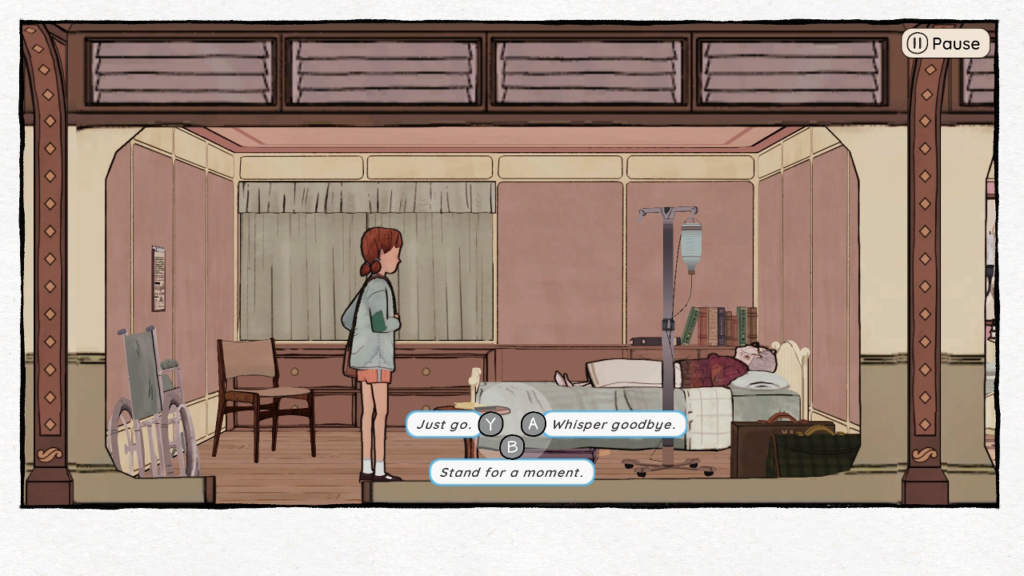
There is just enough time to catch most of Wayward Strand’s events and conversations in a single playthrough, but not enough to view them all. As Lily notes when Casey first arrives on the ward, “A lot goes on in a hospital. You can’t be everywhere at once!” The only purpose for starting a new game is to see what conversations or private moments I might have missed last time. I haven’t fully experienced this videogame until I’ve played it at least twice, and its brisk four-hour run time makes this a reasonable proposition.
Wayward Strand is significant in its inconsequentiality. It is simple to play. All I can do is point Casey up and down hallways and step into rooms if someone is there to talk. It finds its life and entertainment through the conversations she shares with the patients. They are lively, sometimes funny, sometimes sad, and always enthralling. It’s one of this year’s best-written videogames, and it’s an easy and whole-hearted recommendation for anyone looking for something a little slower, a little quieter, and a little sweeter to break up the repetitive drone of typical videogame fare.